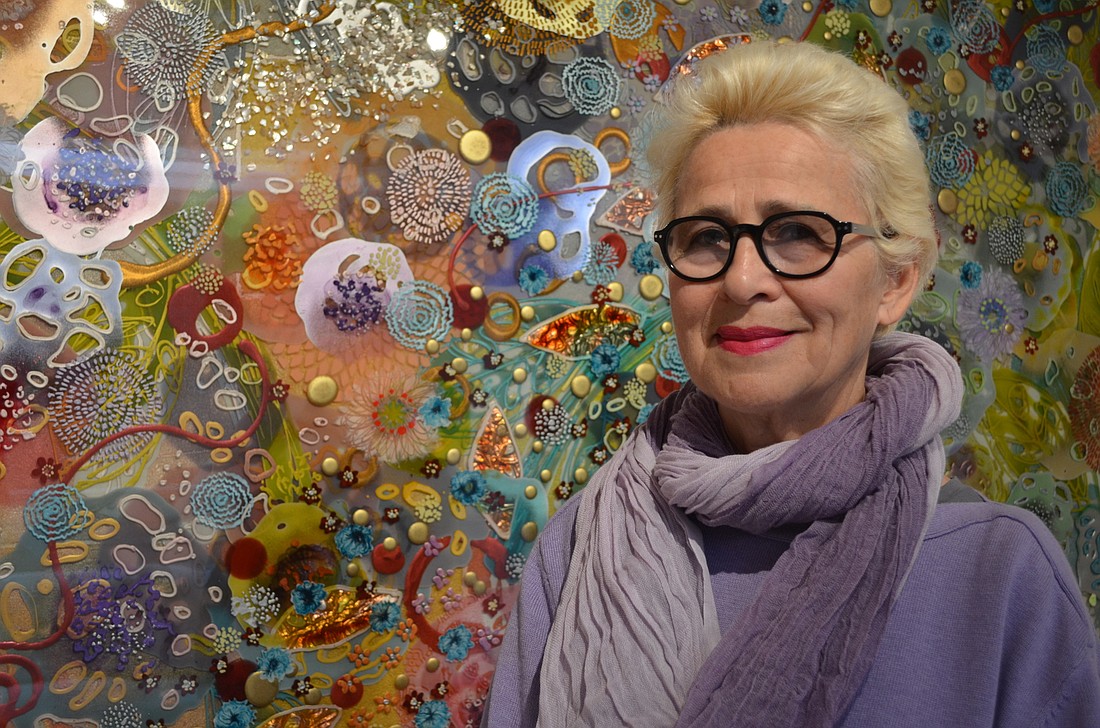- March 30, 2025
-
-
Loading

Loading

Describing art isn’t always easy. Describing abstract pieces can be a bigger challenge. When words fail, Andrea Dasha Reich uses food.
“My work is like a BLT,” she says. “It’s all about layers. Picture the sandwich — the bread is the foundation, and on top, you have the lettuce, tomato and bacon. My paintings are the same way; I start with a canvas, and then I add more and more layers. I’m continuously trying to add depth.”
Reich works in a material that’s much less common — and edible — than that of her aforementioned sandwich. The internationally known and collected abstract artist is one of the few artists in the world whose medium of choice is epoxy resin: a clear, reactive chemical most commonly used as a sealant for bar tops. In her art, it’s often mistaken for glass. There are others who use the material, but nobody, she says, is doing quite what she is.
Born in Prague and schooled in painting at Jerusalem’s Bezalel Academy of Arts and Design, Reich became well known among art collectors around the world for her paintings — massive constructs of seemingly endless layers of vibrant, playful color.
It’s the type of work whose detail can’t be fully conveyed through photographs. The layers of dyed resin and paint create a surprising level of depth, and one could spend days exploring its details. As Reich puts it, “It wants to have a conversation with you.”
It’s also extremely heavy.
In search of a more back-saving method of working with her beloved material, Reich stumbled upon a new technique that’s completely changed the direction of her work.
“I was playing with the resin one day,” she says. “And I realized that at a certain point, I could manipulate it and create three-dimensional pieces. That was a revelation to me. I’ve always tried to get more and more depth out of my paintings, but it was never enough. I think I was a frustrated sculptor all along, and I never knew it.”
An Unpredictable Material
Reich first discovered epoxy resin 20 years ago, when she was painting a table for her own home. Her husband suggested she use the material to seal the work and make it last longer.
It was love at first sight.
“The moment I saw the resin poured over my work,” she says, “I knew I loved it. It’s a marriage between the material and the art I’m creating. The resin has this ability to make color pop like nothing else I’ve seen.”
The material can also be a bit capricious. The process starts in Reich’s 3,000-square-foot Twin Lakes Park studio, where she mixes the prepolymer and polymer together and adds dyes. The ingredients react, and the honey-like liquid becomes hard to the touch within 48 hours and continues to set for up to a few weeks. The process is always the same. The results rarely are.
“It’s completely unpredictable,” she says. “You have to be patient, and you need a good sense of humor. One day, it will take eight hours to shape it, and the next day, it could take 15. I have to watch it like a baby. If only it had a monitor.”
A New Direction
Reich molds the semi-hardened resin to create sculptures, which she calls foldings, that nod to the draping cloths often seen in Renaissance-era religious sculptures, such as Michelangelo’s Pietà.
Unlike her other work, her foldings are a simple, understated shade of off-white, making her transition into sculpture all the more risky.
“Change is always scary,” she says. “Many artists are afraid of change, but I couldn’t keep doing the same work. I always want to move farther. I’m sure this will lead me to something else.”
Reich’s new work is currently on display at Alfstad& Contemporary, and she says she’s eager to show off her new style and introduce people to the material she loves.
“My work is a complete reflection of myself,” she says. “I’m a happy person, and I think people can see that in my art. I hope people recognize resin as a serious medium with great potential to create things that wouldn’t be possible with other materials. I hope they fall in love with it, just like I did.”